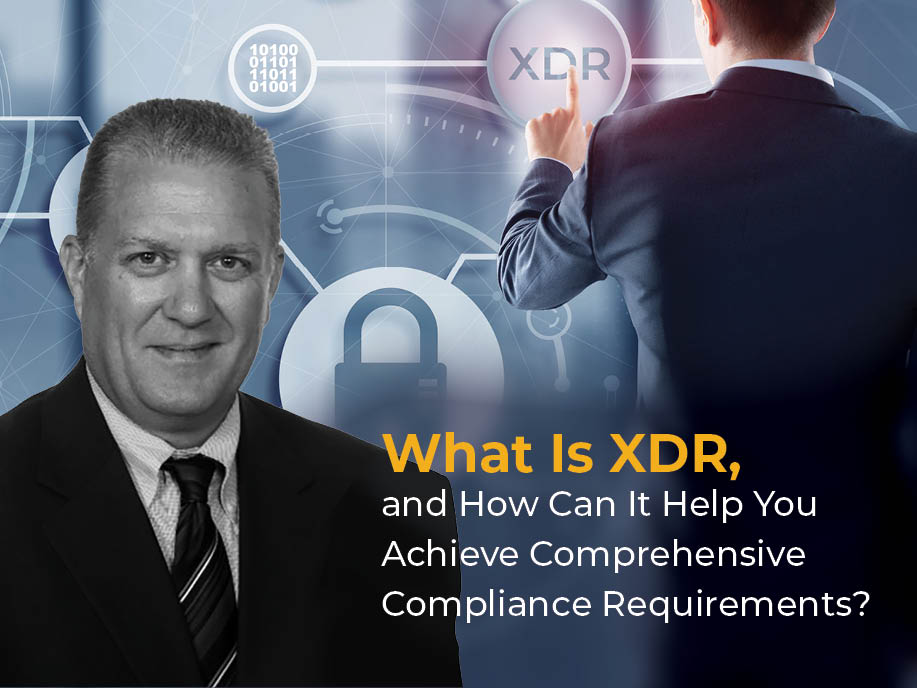What Is XDR, and How Can It Help You Achieve Comprehensive Compliance Requirements?
By: Randy Griffith, Senior Security Consultant, Strategy and Risk
What Is XDR?
XDR is an advanced cybersecurity solution designed to provide comprehensive threat detection, response, and investigation across multiple security layers and environments. Unlike traditional security tools that focus on specific threat vectors or siloed components, XDR has the ability to integrate and analyze data from many various sources to offer a more complete and context-aware approach to cybersecurity.

XDR helps you achieve compliance requirements by doing the following:
1. Integrates Security Components
- Endpoints: Consolidates data from a range of endpoints, including desktops, laptops, and servers in different physical locations
- Networks: Monitors network traffic, and identifies potential threats and anomalies
- Cloud environments: Extends its capabilities to cloud platforms, ensuring coverage across on-premises as well as cloud infrastructure
2. Correlates and Analyzes Data
- Employs advanced analytics, machine learning, and behavioral analysis to correlate data from multiple and different sources
- Identifies complex and sophisticated threats by analyzing patterns and behaviors that traditional security tools might miss
3. Automates Threat Detection
- Uses automation and machine learning to detect and prioritize potential threats in real time
- Reduces the time from threat detection to response initiation, which is critical for preventing or minimizing damage from cyber attacks
4. Streamlines Incident Response and Investigation
- Streamlines the incident response process by providing comprehensive details about the nature of threats
- Provides details which enable security teams to investigate incidents more efficiently, with contextual information that allows them to isolate and contain an incident. This leads to faster resolutions of cyber events.
5. Scalable and Flexible
- Meets the demands of organizations, regardless of size and complexity and adapts to dynamically different environments
- Adapts to different infrastructures, supporting organizations as they expand and adopt new technologies
How XDR Aids in Achieving Compliance Requirements
Regardless of what compliance-required security standards your organization is trying to meet, XDR can help you achieve them with:
1. Real-time Monitoring
- Ensures continuous monitoring of security events across all relevant endpoints, networks, and cloud environments
- Enables compliance with regulations that mandate prompt detection and response to security incidents
2. Data Visibility and Control
- Provides organizations with enhanced visibility into their data flows so they can maintain control over their sensitive information
- Assists in addressing compliance standards that require provisions for data protection
3. Rapid Threat Mitigation and Incident Response
- Contributes to rapid threat mitigation through automated detection and response capabilities
- Meets compliance mandates that stress the importance of timely incident response through automated features
4. Continuous Improvement
- Supports a continuous improvement cycle by providing insights into security incidents and vulnerabilities
- Refines organizational security strategies and demonstrates an ongoing commitment to compliance via regular analysis of data
5. Provides a Holistic Approach
- Aligns with the multifaceted nature of compliance requirements
- Addresses security concerns across endpoints, servers, networks, and the cloud, ensuring that organizations implement well-rounded security practices
How XDR Can Help You Meet Regulatory Compliance Requirements
Depending on your industry and/or sector, your organization will likely need to comply with regulatory requirements for protecting privacy, data, and your systems. XDR can help with the standards described below—as well as many others.
1. HIPAA (Health Insurance Portability and Accountability Act)
Health care organizations are entrusted with vast amounts of sensitive patient information—the HIPAA Privacy Rule specifically relates to protected health information (PHI). That’s why it’s crucial they comply with HIPAA regulations. XDR can play a pivotal role in helping these organizations safeguard healthcare data and PHI with real-time threat detection and response capabilities. Able to correlate and analyze data across multiple security layers, XDR ensures that healthcare entities can identify and mitigate potential breaches accurately and promptly.
2. GDPR (General Data Protection Regulation)
GDPR mandates stringent data protection measures for organizations handling European Union citizens’ personal data. XDR helps organizations meet GDPR compliance by offering comprehensive visibility into data-related activities. By monitoring and analyzing endpoint, servers, network, and cloud data, XDR helps organizations identify and respond to potential data breaches, ensuring adherence to GDPR’s strict data protection principles.
3. PCI DSS (Payment Card Industry Data Security Standard)
Businesses involved in processing credit card payment transactions must be compliant with PCI DSS. XDR addresses these requirements by continuously monitoring and analyzing network traffic for suspicious activities. Its ability to detect and respond to anomalous/malicious behavior enhances an organization’s overall security posture so they can maintain a secure environment for cardholder data.
4. SOX (Sarbanes-Oxley Act)
SOX focuses on ensuring the accuracy and reliability of financial information. XDR aids in SOX compliance by providing real-time monitoring of critical systems and applications. Through advanced threat detection and response capabilities, XDR helps organizations prevent unauthorized access and detect it, thereby ensuring the integrity of financial reporting processes.
Conclusion
Becoming and staying compliant is not an option. It’s a necessity for organizations doing business in certain industries and sectors. And it’s becoming increasingly complex, as these industry regulations continue to add more requirements. XDR offers a robust solution that not only strengthens an organization’s security defenses but also aligns with multiple compliance requirements.
By leveraging the power of XDR, your organization can stay ahead of evolving threats, safeguard your own and your clients’ sensitive data, and demonstrate your commitment to maintaining a secure and compliant environment. As regulatory landscapes continue to change, XDR will continue to be a key tool in the ongoing battle against cyber threats.